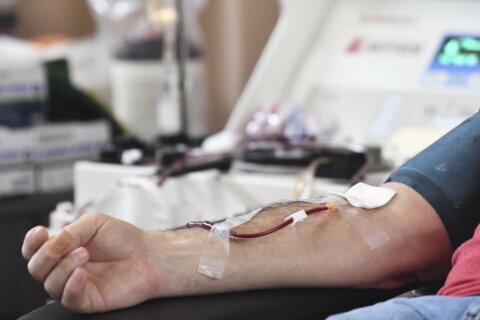WASHINGTON — About six years ago, Garren Givens, 33, was “messing around in the yard,” throwing the football with some friends, when his life drastically changed.
“It was a rather sudden and seemingly insignificant injury,” says Givens, a D.C. resident.
The 26-year-old thought he pulled a muscle, but after a few weeks, the discomfort evolved into a debilitating pain that affected his everyday life.
“Very quickly, I went from being an active individual to someone that had difficulty just lifting a briefcase to go into the office,” he says. “It was a complete shift for me, just in my level of daily routine and activity.”
Imaging tests revealed that Givens had several compression fractures and a few degenerated discs in his lower spine and lumbar area, most likely due to repeat force impact caused by years in sports. He was put on “a number of painkillers” and received frequent cortisone shots just to get to a place where he could function without severe pain.

“It’s now difficult for me to even remember how immobile and inactive I was throughout that period,” he says.
Givens is one of 100 million Americans who suffers from chronic pain, or pain that lasts longer than six months.
While one-third of the American population lives with chronic pain, it was Jennifer Aniston’s recent performance in the critically acclaimed movie “Cake” that shone a spotlight on the debilitating disease and the dangerous addiction that can result from painkillers prescribed to treat it.
Historically, pain medication has been a go-to treatment for chronic pain. According to the National Institutes of Health, 76 million prescriptions for opioids were written for pain treatment in 1991; in 2011, that number reached 219 million.
But in the past few years, emerging technologies and alternative approaches to pain management have given patients and physicians new options for treatment.
Determining the cause of chronic pain
Dr. Aneesh Singla, medical director at Rockville, Maryland’s National Spine and Pain Centers, explains chronic pain can be caused by a number of factors, from a herniated disc to a narrowing spine to whiplash from a car accident. And determining the cause — the “pain generator” — is critical in treating the pain.
“Pain is one of those things in our bodies that’s kind of an early warning system,” Singla says.
“It’s a protective reflex that allows you to adapt to your environment. And when that protective system becomes dysfunctional because it’s setting off alarm bells or pain signals that are continuous and bothersome, that’s kind of what results in chronic pain.”
One reason why it’s so important to determine the cause of the pain, Singla says, is to prevent the patient from becoming reliant on pain medication. Other treatments options exist — from routine physical therapy to more involved surgeries.
Nonsurgical treatment options
Givens went through a long period of trying to figure out the best way to deal with his pain, and often felt discouraged about the prospect of finding relief.
“A lot of specialists I was seeing at the time … sort of led me to believe that it wasn’t necessarily a possibility that I’d ever get back to where I had been,” Givens says. “From time to time, those things can wear on you psychologically when you don’t find yourself improving or getting better.”
After hearing a few options, and knowing the risks involved, Givens says he knew that he wanted to avoid surgery. When he started seeing Dr. Dan Kendall, a board-certified anesthesiologist and pain physician at National Spine and Pain Centers, he learned about a treatment option called radiofrequency neurotomy.
During the procedure, which can be done in an outpatient setting in about 30 minutes, a heat probe desensitizes the sensory nerves on the joints. For the past four years, Givens has been receiving the treatment every six to nine months and has seen encouraging results.
“It’s given me mobility and activity back in my life,” says Givens, who has gone back to playing golf and doing other moderate forms of exercise.
Despite the notable progress, he is not free from all pain. Givens still lives in some discomfort and receives occasional pain medication injections, which he prefers to pills.
“To me, it helps, because I don’t like feeling cloudy, and so it’s different from taking painkillers orally, and it’s something that can take the edge off, but does so without the negative effects of feeling as though you are on pain medication,” Givens says.
Surgical treatment options
Peripheral nerve stimulation (PNS) is another treatment option for patients experiencing nerve-related chronic pain, and it’s “a procedure that’s made huge advancements over the past decade,” Kendall says.
The treatment involves implanting a small electrical device in the epidural space next to a peripheral nerve to intersect pain signals.
“Essentially, instead of having a pacemaker for the heart, it’s like a pacemaker for pain,” says Kendall, who has been practicing in pain management for the past 10 years.
Evette Maynard-Noel, of Alexandria, Virginia turned to PNS after years of suffering from chronic pain. In 2008, the 47-year-old woke up to severe pain in her neck, shoulders and left arm.
“I couldn’t move and I got really scared,” she says. “I could not turn my neck from the left to the right. I could not bend it forward. It literally just stayed in one position. And my left arm hurt so bad, I had to hold it as if I had it in a sling.”
Maynard-Noel went through a series of diagnostic possibilities with her doctor over the course of a year, ranging from stress to a pulled muscle. Meanwhile, her life as she knew it was crumbling around her. The wife, mother, full-time employee and doctoral student could no longer tackle the daily tasks life threw her way.
“Everything was impacted. I didn’t want to do anything that I had been doing — it just hurt that bad,” she says. And the pain medications she was prescribed weren’t helping: “I didn’t like the way I felt; I didn’t like doing that.”
Eighteen months ago, Maynard-Noel’s physician at National Spine and Pain Centers gave her the option to try a spinal cord stimulator for about a week. The stimulator was placed at the site of her pain, and instead of sending pain signals to her brain, it sends a hum.
“Instead of my pain being registered in my brain and feeling the way that you do when you have pain, all I felt was a slight tingle,” Maynard-Noel says. After her trial session with the stimulator, she decided to proceed with the full PNS operation.
Before the PNS treatment, Maynard-Noel recalls feeling frustrated when doctors would ask her to rank her pain on a scale from one to 10.
“They’d look at me funny when I’d say, ‘I’m off the charts — it’s a 20, a 30.’ I couldn’t describe the type of pain I was having. It was that bad. It was ruining everything that I was.”
Now, she is able to get up, go to work and care for her family, and is hoping to progress to the point where she can train for a race.
Spreading the word to stop chronic pain
A handful of other treatment options for chronic pain are also available to patients, and Dr. Singla says his goal is to spread the word about options outside from long-term pain medication.
“There are a lot of folks out there who don’t know that treatment is available,” he says. In addition to avoiding addiction, he says treating chronic pain also goes hand in hand with treating depression and other chronic issues.
“Sometimes, pain drives people to want to not do very much, and that has health consequences too. You’re going to be more sedentary.You’re going to be less active and that, in and of itself, can cause problems down the road with leading to more chronic illness.”







